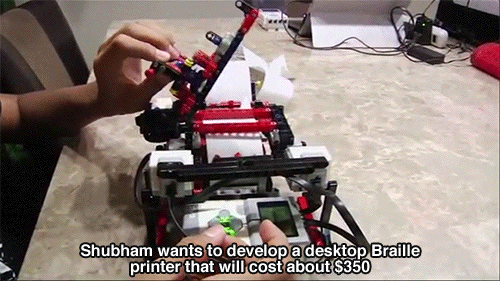Watch: How A Simple Photo Edit Perfectly Illustrates The Importance Of Gender Equality.



Watch: How a simple photo edit perfectly illustrates the importance of gender equality.
More Posts from Dotmpotter and Others

Energy conversion: Speeding up material discovery
Algorithm take months, not years, to find material for improved energy conversion
In even the most fuel-efficient cars, about 60 percent of the total energy of gasoline is lost through heat in the exhaust pipe and radiator. To combat this, researchers are developing new thermoelectic materials that can convert heat into electricity. These semiconducting materials could recirculate electricity back into the vehicle and improve fuel efficiency by up to 5 percent.
The challenge is, current thermoelectric materials for waste heat recovery are very expensive and time consuming to develop. One of the state of the art materials, made from a combination of hafnium and zirconium (elements most commonly used in nuclear reactors), took 15 years from its initial discovery to optimized performance.
Now, researchers from the Harvard John A. Paulson School of Engineering and Applied Sciences (SEAS) have developed an algorithm that can discover and optimize these materials in a matter of months, relying on solving quantum mechanical equations, without any experimental input.
“These thermoelectric systems are very complicated,” said Boris Kozinsky, a recently appointed Associate Professor of Computational Materials Science at SEAS and senior author of the paper. “Semiconducting materials need to have very specific properties to work in this system, including high electrical conductivity, high thermopower, and low thermal conductivity, so that all that heat gets converted into electricity. Our goal was to find a new material that satisfies all the important properties for thermoelectric conversion while at the same time being stable and cheap.”
Read more.

Check in: The Tokyo hotel where guests can curl up with 1,700 good books
Book and Bed, a new Tokyo hotel, has created the sort of space that is impossible to leave. It is a cheap and cheerful dorm with a difference: guests’ bunk beds are hidden behind library shelves filled with hundreds of books in Japanese and English. | Read more

World Pulse, a magazine and online media nonprofit, is a place for women around the world to report on issues that are important to them.
The goal is to give all women a voice that will in turn help them improve their communities and their lives.
"We’re not about professional journalists, we’re more about that emerging woman leader who’s just coming online and has a powerful contribution to make," says founder Jensine Larson.
World Pulse’s “web” of women grows (PBS NewsHour)
The Most Metal Mass Extinction Events, Ranked
in the style of The Toast
That One Unnamed Extinction Event That Happened When Blue-Green Algae Discovered Photosynthesis and Started Pumping the Environment Full of Oxygen, Which Was Toxic to All Other Life on Earth at That Point in Time
This extinction event did result in the extinction of more living organisms than any other, whether you rank by number of individuals, number of orders/genera/species, % of life, or amount of biomass, but they were all single-celled organisms, so they don’t even register on the metal scale.
The Current Slow Slide Due to Anthropogenic Environmental Modification
Habitat destruction isn’t very metal.
Late Devonian
Some super-weird shit died out, which is totally metal, but we have no idea why, which isn’t. It might not even have been an extinction event, just a decrease in the speciation rate. Jawed vertebrates totally unaffected.
End Ordovician
Second-largest extinction event after the End Permian (not counting those blue-green algae fuckers). Caused by tectonic plate shifting (kinda metal) and resulting glaciation (mildly metal).
Deep Impact
Pros: Giant asteroid hitting the earth.
Cons: Fictional.
End Triassic
Probably caused by massive volcanic eruptions, which is pretty metal, but mostly just wiped out some weird looking amphibians, which is only mildly metal.
End Permian
Greatest extinction event of all time (with the exception of that blue-green algae fiasco mentioned above), wiping out ~95% of all species: metal. Only known mass extinction of insects: metal. Probably caused by the biggest volcanic eruptions since life began (metal) which ignited massive coal beds (metal) and caused the release of methane from the ocean floor (metal) resulting in a runaway greenhouse effect that raised the average ocean temperature to 40C for several million years, essentially boiling the earth alive (super metal). Paved the way for dinosaurs to take over the earth: metal. Known as the ‘Great Dying’: totally metal.
However, most of the extinctions occurred in sessile marine organisms, which are way too boring to be metal, and for the first ~20 million years after the extinction event, land was dominated by Lystrosaurus, which is the most un-metal looking reptile you can think of.
End Cretaceous, aka the K-T Event
A GIANT FLAMING BALL OF ROCK HIT THE EARTH AND KILLED ALL THE (non-avian) DINOSAURS. ENOUGH SAID.
No amount of multivitamins, yoga, meditation, sweaty exercise, superfoods or extreme time management, as brilliant as all these things can be, is going to save us from the effects of too much work. This is not something we can adapt to. Not something we need to adjust the rest of our lives around. It is not possible and it’s unethical to pretend otherwise. Like a low-flying plane, the insidious culture of overwork is deafening and the only way we can really feel better is if we can find a way to make it stop.
No, it’s not you: why ‘wellness’ isn’t the answer to overwork (via brutereason)
my man went for it



Teen Starts Company To Make Low-Cost Printers To Help Blind People
SANTA CLARA, Calif. (AP) — In Silicon Valley, it’s never too early to become an entrepreneur. Just ask 13-year-old Shubham Banerjee. The California eighth-grader has launched a company to develop low-cost machines to print Braille, the tactile writing system for the visually impaired. Tech giant Intel Corp. recently invested in his startup, Braigo Labs.
For behind this incredible technology go here.

G20 Governments collectively handed out $452bn in subsidies for fossil fuels in both 2013 and 2014 - four times the amount allocated globally for renewables.
(via Fossil fuels receive four times as many subsidies as renewables, report finds)

UAV Will Determine Best Locations for Wind Energy
-
 holographicpixietrash liked this · 9 years ago
holographicpixietrash liked this · 9 years ago -
 everydayechos reblogged this · 9 years ago
everydayechos reblogged this · 9 years ago -
 whelpokaythen reblogged this · 9 years ago
whelpokaythen reblogged this · 9 years ago -
 restless-mind-syndrome liked this · 9 years ago
restless-mind-syndrome liked this · 9 years ago -
 dotmpotter reblogged this · 9 years ago
dotmpotter reblogged this · 9 years ago -
 all-the-things-are-taken reblogged this · 9 years ago
all-the-things-are-taken reblogged this · 9 years ago -
 themrsdanielsousa reblogged this · 9 years ago
themrsdanielsousa reblogged this · 9 years ago -
 themrsdanielsousa liked this · 9 years ago
themrsdanielsousa liked this · 9 years ago -
 alexroberts182 reblogged this · 9 years ago
alexroberts182 reblogged this · 9 years ago -
 alexroberts182 liked this · 9 years ago
alexroberts182 liked this · 9 years ago -
 forestmgmt liked this · 9 years ago
forestmgmt liked this · 9 years ago -
 itscaptainlime reblogged this · 9 years ago
itscaptainlime reblogged this · 9 years ago -
 itscaptainlime liked this · 9 years ago
itscaptainlime liked this · 9 years ago -
 sinhala-kella reblogged this · 9 years ago
sinhala-kella reblogged this · 9 years ago -
 lunaslashsea liked this · 9 years ago
lunaslashsea liked this · 9 years ago -
 not-tomhanks reblogged this · 9 years ago
not-tomhanks reblogged this · 9 years ago -
 urbanoceanix reblogged this · 9 years ago
urbanoceanix reblogged this · 9 years ago -
 krystellcastaneda reblogged this · 9 years ago
krystellcastaneda reblogged this · 9 years ago -
 krystellcastaneda liked this · 9 years ago
krystellcastaneda liked this · 9 years ago -
 an-isolated-nexus reblogged this · 9 years ago
an-isolated-nexus reblogged this · 9 years ago -
 cumulatedbrainwaves liked this · 9 years ago
cumulatedbrainwaves liked this · 9 years ago -
 sequinednazrati liked this · 9 years ago
sequinednazrati liked this · 9 years ago -
 sonnymerrill137 reblogged this · 9 years ago
sonnymerrill137 reblogged this · 9 years ago -
 hellosocialchameleons liked this · 9 years ago
hellosocialchameleons liked this · 9 years ago -
 eco-gnome-ics reblogged this · 9 years ago
eco-gnome-ics reblogged this · 9 years ago -
 an-isolated-nexus liked this · 9 years ago
an-isolated-nexus liked this · 9 years ago -
 missotaku1090 liked this · 9 years ago
missotaku1090 liked this · 9 years ago -
 industryinthestreets liked this · 9 years ago
industryinthestreets liked this · 9 years ago -
 deathbyclarinet reblogged this · 9 years ago
deathbyclarinet reblogged this · 9 years ago -
 iglooser reblogged this · 9 years ago
iglooser reblogged this · 9 years ago -
 i-give-your-boyfriend-boners liked this · 9 years ago
i-give-your-boyfriend-boners liked this · 9 years ago -
 mdchemey reblogged this · 9 years ago
mdchemey reblogged this · 9 years ago -
 ursa-borealis liked this · 9 years ago
ursa-borealis liked this · 9 years ago -
 themusicstopped liked this · 9 years ago
themusicstopped liked this · 9 years ago -
 celestialequator liked this · 9 years ago
celestialequator liked this · 9 years ago -
 emmakickass reblogged this · 9 years ago
emmakickass reblogged this · 9 years ago -
 heartshapedspatula liked this · 9 years ago
heartshapedspatula liked this · 9 years ago -
 tinfoilkenku liked this · 9 years ago
tinfoilkenku liked this · 9 years ago -
 amplifytoo reblogged this · 9 years ago
amplifytoo reblogged this · 9 years ago -
 onlyirroniclyhappy reblogged this · 9 years ago
onlyirroniclyhappy reblogged this · 9 years ago -
 onlyirroniclyhappy liked this · 9 years ago
onlyirroniclyhappy liked this · 9 years ago
![Map Of The Humongous Fungus: The Largest Living Organism On Earth [1936x1310][OC] CLICK HERE FOR MORE](https://64.media.tumblr.com/db929150f86f0c503804f329c0244a28/tumblr_nyulclrmRz1s6c1p2o1_500.jpg)